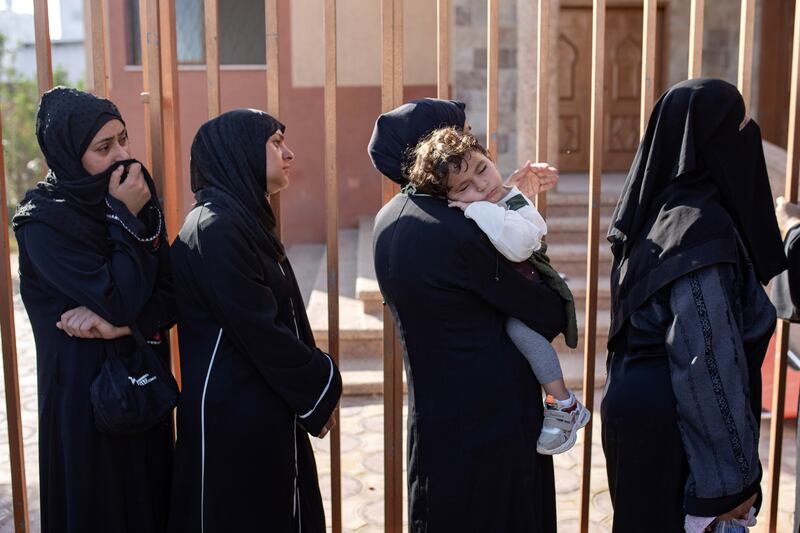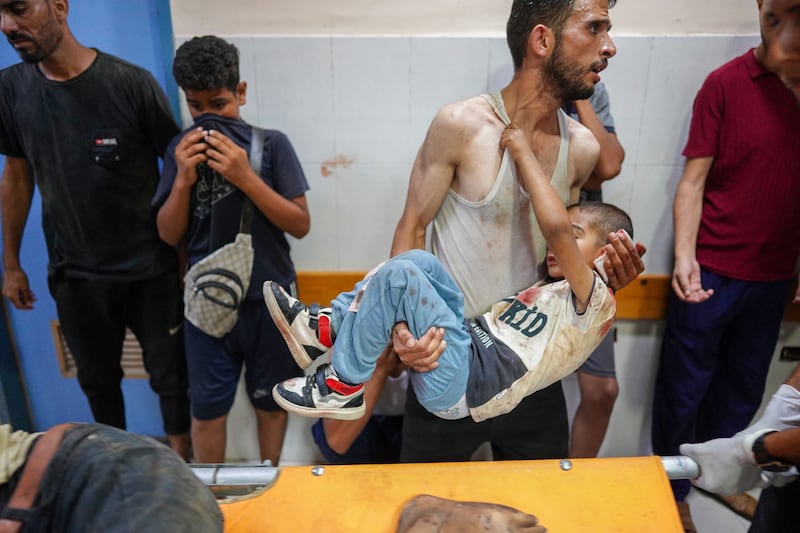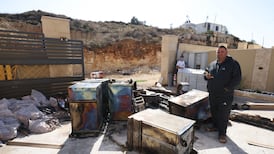The football went out of bounds and the goalkeeper was lofting it toward his team-mates as dozens of people looked on from the sidelines of the courtyard. It was a moment of respite in the Gaza Strip – but it did not last. Before the ball reached the ground, a large boom shook the yard, sending players and spectators fleeing in frenzied panic.
The Gaza authorities say at least 27 people were killed in that explosion on Tuesday, which was caused by an Israeli air strike near the entrance to a school turned shelter on the outskirts of Khan Younis, in southern Gaza.
Iyad Qadeh, who was sitting outside his home near the school property, said the day had been calm, without drones buzzing overhead. Then a warplane appeared and fired a missile toward a group of young men sitting at an internet cafe, he said.
“After that, it was screams and body parts everywhere,” Qadeh said.
READ MORE
Philippe Lazzarini, head of UNRWA, the UN agency that helps Palestinians, said on Wednesday it was the fourth strike in four days to hit or damage a school building in Gaza. Two-thirds of UN school buildings in the enclave have been hit since the start of the war, with more than 500 people killed, the agency said.

The Israeli military said the strike on Tuesday had been targeting a Hamas member who took part in the October 7th attacks on Israel that set off the war. It did not release details on the identity of the Hamas member or whether the target had been killed. The military said it was “looking into reports that civilians were harmed”.
The explosion came amid a week of punishing air strikes and fighting across the Gaza Strip, with the Israeli military urging people in Gaza City to once again flee and mediators once again seeking to advance ceasefire talks.
Most of those injured or killed in the strike Tuesday were taken to Nasser Hospital in Khan Younis by ambulance, private vehicle or donkey cart. The condition of the bodies made it difficult to determine the identities of the dead or even the number, Dr Mohammed Saqer, the director general of nursing at Nasser, said on Wednesday.
“There were 56 wounded, and most of them were children and women,” Saqer said. About 10 people underwent amputations. “Hands and feet completely blown off.”
With most of the territory’s 2.2 million residents driven from their homes by the Israeli bombardment and ground assault, school buildings have become critical shelters for Palestinians in Gaza. The Israeli military has claimed that militants are using shelters and other civilian infrastructure to hide themselves and their activities.
[ Bodies trapped in Gaza City under Israeli assault as mediators seek truceOpens in new window ]
A video of the soccer match capturing the moment of the strike on Tuesday at Al-Awda School, which was shared by Al Jazeera and verified by the New York Times, is one of the more harrowing of the war.
The person shooting the video runs toward the entrance of the school, and the camera pans across a scene of devastation. Shredded bodies lie on the ground amid debris, and desperate screams can be heard. “Oh, God,” someone yells.
Some 20km north of the school, there were signs on Wednesday that the renewed fighting, which Israel says is intended to crack down on a resurgent Hamas insurgency, would continue.
The Israeli military said in the evening that it was withdrawing forces from one Gaza City neighbourhood, Shijaiyah, even as it called for Palestinians across the city to leave. Israeli troops sent ground forces into Shijaiyah late last month, and the fighting then expanded to other parts of the city.
The military said that it had concluded its operation in Shijaiyah, but it gave little indication that the end of operations there meant that its seemingly endless fight against Palestinian militants was close to a conclusion.
“Gaza City will remain a dangerous combat zone,” the military said in a statement. Israeli forces, however, retreated from some Gaza City districts overnight on Thursday.

As ceasefire negotiations drag on, Israeli troops continue to return to fight in places in Gaza they had once deemed secure.
In January, the Israeli military dialled back the intensity of its military operation in Gaza City and the rest of the north. But since then, Israeli forces have carried out a series of targeted campaigns in the area. In March, its troops raided Shifa hospital for a second time, killing nearly 200 people it called “terrorists” and leaving devastation behind after extended gun battles with Palestinian militants.
It is not clear how many Hamas fighters remain in Gaza City.
In statements on social media, Hamas has said over recent few days that its forces were fighting Israeli troops in Shijaiyah and Tel al-Hawa. In Shijaiyah alone, Israel claims its troops have eliminated “more than 150 terrorists” over the past week and have destroyed six underground tunnels.
The bombardments in Gaza come at a time when the few still-functioning hospitals there are struggling to stay open amid a lack of medicine, medical equipment and reliable power. “Many of our medical staff have been detained, many have been killed and many have had to leave Gaza,” Saqer said.
There is also a shortage of hospital beds. Most of the air strike victims on Tuesday were treated on the floors of wards or in the hallways, Saqer said.
A video taken by Reuters appeared to indicate the type of bomb used in the strike.
Two weapons experts – Trevor Ball, a former US army explosive ordnance disposal technician; and Patrick Senft, a weapons expert at the consulting firm Armament Research Services – identified fragments seen in the video as coming from a “small diameter” bomb known as a GBU-39.
The precision-guided bomb, which is US-made, weighs about 110kg and is increasingly the weapon of choice for the Israeli military. Two of them were used in a deadly strike on a tent camp in Rafah on May 26th.
In Gaza, such bombs “are often used to target specific floors in buildings, penetrating through the roof before detonating,” Ball said.
But he said that while they are smaller in explosive power than the 900kg bombs that have been used elsewhere in Gaza, the bombs “can still cause significant injury and death, especially when used in areas where there is little to no protection for people from blast and fragmentation effects, such as a street, or area with just tents.”
– This article originally appeared in The New York Times




















